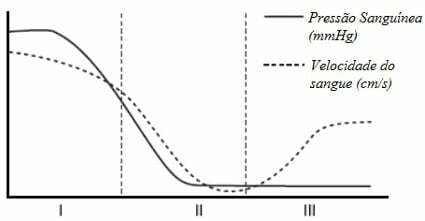
You blood vessels are divided into veins, arteries and capillaries that are differentiated by the structure of the walls of each one. Arteries are thicker and have a larger caliber, veins are less elastic and capillaries are extremely thin.
We prepared this list of exercises on differences between vein, artery and capillary so you can test your knowledge about blood vessels.
see more
Biology teacher fired after class on XX and XY chromosomes;…
Cannabidiol found in common plant in Brazil brings new perspective…
You can consult the feedback and save this list of exercises in PDF at the end of the post!
1) (FUVEST) The graph below shows the variation in blood pressure and blood velocity in different vessels of the human circulatory system.
 Which of the alternatives correctly correlates regions I, II and III, respectively, of the graph with the type of blood vessel?
Which of the alternatives correctly correlates regions I, II and III, respectively, of the graph with the type of blood vessel?
a) Artery, capillary, vein.
b) Artery, vein, capillary.
c) Artery, vein, artery.
d) Vein, capillary, artery.
e) Vein, artery, capillary.
2) Blood vessels are structures that are part of the cardiovascular system and are formed by layers called tunics. The most internally arranged tunic found in all blood vessels is called the:
the average.
b) adventitia.
c) internal.
d) intimate.
e) elastic.
3) (UFSCar) If we could mark a single red blood cell of a person, when it passes through a capillary blood flow of the foot, and follow its path through the body from there, we would detect its passage, successively, through the inner:
a) arteries ⇒ veins ⇒ heart ⇒ arteries ⇒ lung ⇒ veins ⇒
b) arteries ⇒ heart ⇒ veins ⇒ lung ⇒ veins ⇒ heart ⇒ arteries ⇒
c) veins ⇒ arteries ⇒ heart ⇒ veins ⇒ lung ⇒ arteries ⇒
d) veins ⇒ lung ⇒ arteries ⇒ heart ⇒ veins ⇒ lung ⇒ arteries ⇒
e) veins ⇒ heart ⇒ arteries ⇒ lung ⇒ veins ⇒ heart ⇒ arteries ⇒
4) Mark the incorrect alternative:
a) Arteries, veins and capillaries are blood vessels.
b) blood vessels are generally formed by three tunics: tunica intima, tunica media and tunica adventitia.
c) arteries have a more developed tunica intima than other types of vessels.
d) veins have valves that prevent the backflow of blood.
e) capillaries are thin blood vessels that allow the passage of nutrients.
5) Previously, it was very common to hear people say that arteries are blood vessels that carry blood artery (rich in oxygen), while veins are responsible for transporting venous blood (rich in gas carbonic). It is worth mentioning, however, that there are veins that carry arterial blood and arteries that carry venous blood. Mark the alternative that indicates the name of those arteries and veins that make the above definition incorrect.
a) Aorta and vena cava.
b) Renal artery and renal vein.
c) Pulmonary artery and pulmonary vein.
d) Femoral artery and saphenous vein.
e) Carotid artery and brachiocephalic vein.
6) The vessels that carry blood from the heart to the tissues are called:
a) veins.
b) venules.
c) arteries.
d) saphenous vein.
e) capillaries.
7) A student in an anatomy class observed a blood vessel with a peculiar characteristic: it had a series of folds that started from the tunica intima. These blood vessels can be called:
a) aorta.
b) artery.
c) vein.
d) capillary.
e) saphenous vein.
8) Arteries are types of blood vessels, just like veins and capillaries. Carefully analyze the following alternatives and select the one that best defines an artery.
a) Arteries are the blood vessels responsible for transporting arterial blood, rich in oxygen.
b) Arteries are strong blood vessels that ensure that blood is transported from the tissues to the heart.
c) Arteries are thin blood vessels in which gas exchange is observed.
d) Arteries are blood vessels that carry blood from the heart to the various tissues of the body.
e) Arteries are resistant, thick blood vessels that have valves that prevent the backflow of blood, since blood circulates in these vessels at low pressure.
9) In general, blood vessels have three layers: tunica intima, tunica media and tunica adventitia. In _______________, the tunica media is much thicker than in other vessels, and in _______________, the absence of tunica media and adventitia is observed.
Mark the alternative that best completes the spaces:
a) veins and arteries.
b) arteries and veins.
c) arteries and capillaries.
d) capillaries and arteries.
e) veins and capillaries.
10) A blood vessel that has valves to prevent backflow of blood is called:
oat.
b) capillary.
c) artery.
d) aorta.
i) arteriole.
1 – the
2 – d
3 – and
4 – c
5 – c
6 – c
7 – c
8 – d
9 – c
10 – the
Click here to save this list of exercises in PDF!
See too:


